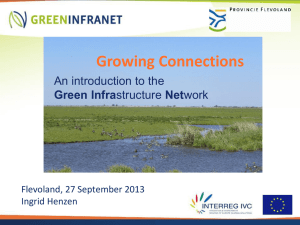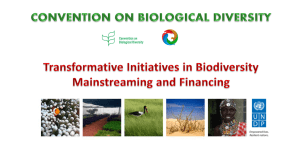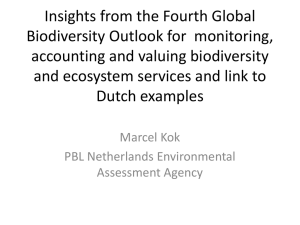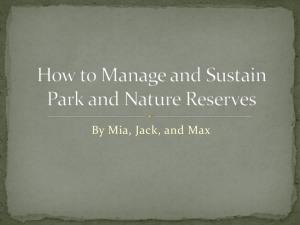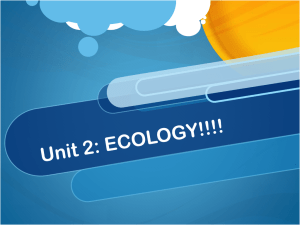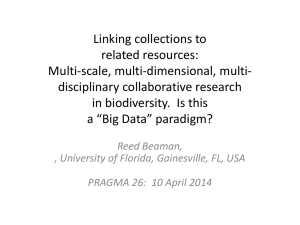Biodiversity and Availability of Medicines
advertisement
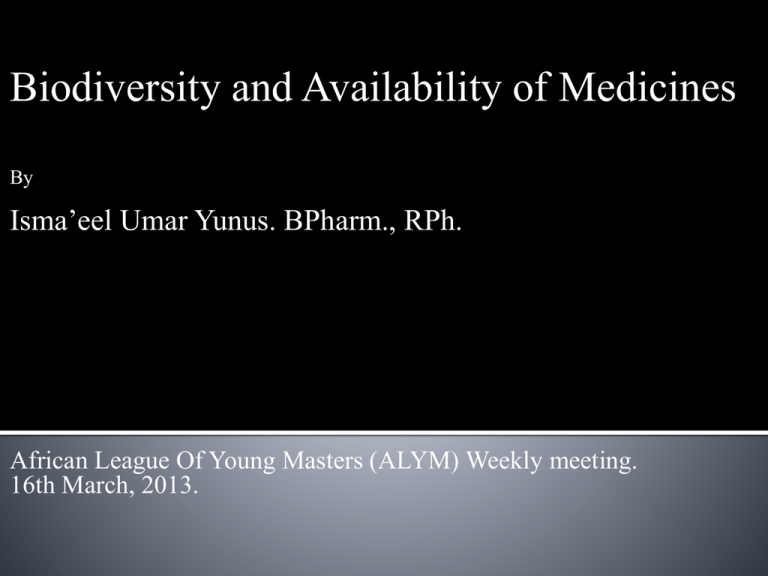
Biodiversity and Availability of Medicines By Isma’eel Umar Yunus. BPharm., RPh. African League Of Young Masters (ALYM) Weekly meeting. 16th March, 2013. The meaning of Biodiversity. The scope of Biodiversity. The benefits of Biodiversity. Biodiversity as the main source of medicines. Threats to Biodiversity. Methods to conserve Biodiversity. Biodiversity or in other words Biological diversity is the scientific term used for the variety of life on earth. This includes millions of plants, animals and microorganisms, the genes they contain and the ecosystem of which they are part of. Biodiversity is everywhere It occurs both on land and in water from high altitudes to deep ocean trenches and it includes all organisms, from microscopic bacteria to more complex plants and animals. Biodiversity remains difficult to measure precisely. According to the Millennium Ecosystem Assessment, the total number of species on earth ranges from 5 to 30 million and only 1.7 to 2 million species have been formally identified. Consumptive Values: Food/Drink Fuel Medicine Batter crop varieties Industrial Material Non-Consumptive Values: Recreation Education and Research Traditional value Plants, animals and microorganisms are the major sources of medicines worldwide. A World Health Organization (WHO) survey revealed 70 to 80% of the world population uses non conventional medicines (mainly herbal sources) for primary healthcare. Most of the non conventional drugs are used by less developed countries. Despite great advances in rational drug design in which medicines are synthesized based on scientific knowledge of their target, most prescribed medicines used in Industrialized countries are still derived from or patterned after natural compounds from plants, animals and microorganisms. Some compounds from plants that has been particularly useful for human medicine include: 1. Paclitaxel from Pacific Yew tree (Taxus brevifolia) used in the treatment of metastatic breast and ovarian cancer. 2. Quinine from Cinchona tree (Cinchona ledgeriana, Cinchona officinalis) used in the treatment of malaria, other antimalarials such as chloroquine and mefloquine were synthesized through the knowledge of its chemical structure. www.homeopathyandmore.com 3. Artemisinin from Artemisia annua considered the most effective antimalarial in use today. 4. Morphine from the Opium poppy (Papaver somniferum) used as a pain reliever in diverse clinical situations. 5. Aspirin from Willow tree (Salix alba vulgaris), used as a pain reliever and in preventing cardiovascular (Heart and Blood vessels) diseases. 6. Coumadin ,an anticoagulant from spoiled sweet clover (Melitus species), used in clearing blood cloth in a number of medical conditions. 7. Vincristine from Periwinkle (Catharanthus roseus) which has revolutionized the treatment of Hodgkin’s lymphoma, turning a disease that was once uniformly fatal into one that can now be totally cured in many patients and vincristine which has done the same for acute leukaemia. 8. Digoxin from foxglove (Digitalis purpurea), used in the management of heart failure and cardiac arrhythmias (abnormal heart rhythm) 1. Captopril and its analogues from the knowledge of the effect of Pit viper (Brothrops jararaca). Used in the treatment of hypertension and heart failure. 2. Prostaglandin E2 (Dinoprostone), is of importance in induction of labour and the treatment of gastric ulcersdiscovered in the two species of gastric brooding frogs found only in the rainforests of Queensland. 3. Zidovudine (Azidothymidine) used in the treatment of HIV/AIDS patterned after compounds made by the marine sponge Cryptotethya crypta. It was the first breakthrough in the management of HIV/AIDS. www.bioweb.uwlax.edu Microorganisms has been the source of almost all antibiotics currently in use. This may include among lots of others: 1. Penicillins (E.g. Penicillin G, Ampicillin, Amoxicillin) from Penicillum nonatum 2. Cephalosporins (E.g. Cephtriaxone, Cefotaxim, Cephalexin) from Cephalosporium acremonium. 3. Streptomycin from soil samples of the actinobacterium Streptomyces griseus was the first remedy for tuberculosis. 4.Tetracycline from fungus-like, soil dwelling bacterium called Streptomyces aureofaciens. Other non antibiotic drugs from microorganisms include: 1. Cholesterol lowering Statins (E.g. Simvastatin), used in preventing heart diseases. 2. Anticancer drugs like Adriamycin used in the treatment of leukemia and multiple myeloma (A form of bone marrow cancer). 3. Ciclosporin from fungus Tolypocladium inflatum found in samples of soil used in preventing organ rejection following organ transplantation. Bio-prospecting in the context of Pharmaceutical drugs refers to the extraction and screening of chemical compounds from natural sources to develop useful leads for potentially new drugs. In its early stage, prospecting largely centered on plants from the ecosystem forest but in recent years various forms of biodiversity like insects, algae, and microorganisms. Nearly half of all cancer drugs approved by the USA Food and Drug Administration between 1940s and 2010 were developed from natural products or derivatives of natural products. All the medicinal benefits of biodiversity highlighted earlier could be lost if threats to biodiversity are not being checked. Identified threats to biodiversity includes Over exploitation ( over hunting and over harvesting) Habitat loss/Degradation/Fragmentation Invasion of non native species Climate Change Pollution Increase in population Global Status of ecosystem services evaluated in the Millennium ecosystem Assessment (2005) showed the findings below An upwards arrow indicates that the condition of the service globally has been enhanced and a downwards arrow that it has been degraded Stop over harvesting Sustainable yield. Hunting and fishing laws. Protect habitat Refuges, Parks, Preserves. Endangered species Act Millennium Ecosystem Assessment. Ecosystems and human well-being : wetlands and water synthesis : a report of the Millennium Ecosystem Assessment.2005. Powledge, Fred. "The Millennium Assessment“. Bioscience (2006)56 (11): 880 Post-2010 Strategic Plan of the Convention on Biological Diversity Tenth meeting of the Conference of the Parties, 18-29 October, 2010 Nagoya, Japan Turner, W. R., Brandon, K., et al. Global conservation of Biodiversity and ecosystem services. (2007) Bioscience 57, 868-873. Chivian, E. & Bernstein, A. Sustaining Life: How Human Health Depends on Biodiversity.(2008) New York, NY: Oxford University Press.


